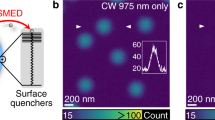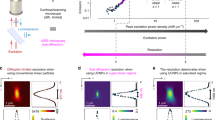Abstract
Super-resolution optical microscopy is providing a new means by which to view as yet unseen details on a nanoscopic scale. Current far-field super-resolution techniques rely on fluorescence as the readout1,2,3,4,5. Here, we demonstrate a scheme for breaking the diffraction limit in far-field imaging of non-fluorescent species by using spatially controlled saturation of electronic absorption. Our method is based on a pump–probe process where a modulated pump field perturbs the charge carrier density in a sample, thus modulating the transmission of a probe field. A doughnut-shaped laser beam is then added to transiently saturate the electronic transition in the periphery of the focal volume, so the induced modulation in the sequential probe pulse only occurs at the focal centre. By raster-scanning the three collinearly aligned beams, high-speed subdiffraction-limited imaging of graphite nanoplatelets is performed. This technique has the potential to enable super-resolution imaging of nanomaterials and non-fluorescent chromophores, which may remain out of reach to fluorescence-based methods.
This is a preview of subscription content, access via your institution
Access options
Subscribe to this journal
Receive 12 print issues and online access
$209.00 per year
only $17.42 per issue
Buy this article
- Purchase on Springer Link
- Instant access to full article PDF
Prices may be subject to local taxes which are calculated during checkout




Similar content being viewed by others
References
Hell, S. W. & Wichmann, J. Breaking the diffraction resolution limit by stimulated emission: stimulated-emission–depletion fluorescence microscopy. Opt. Lett. 19, 780–782 (1994).
Bretschneider, S., Eggeling, C. & Hell, S. W. Breaking the diffraction barrier in fluorescence microscopy by optical shelving. Phys. Rev. Lett. 98, 218103 (2007).
Gustafsson, M. G. L. Nonlinear structured-illumination microscopy: wide-field fluorescence imaging with theoretically unlimited resolution. Proc. Natl Acad. Sci. USA 102, 13081–13086 (2005).
Rust, M. J., Bates, M. & Zhuang, X. Sub-diffraction-limit imaging by stochastic optical reconstruction microscopy (STORM). Nat. methods 3, 793–796 (2006).
Betzig, E. et al. Imaging intracellular fluorescent proteins at nanometer resolution. Science 313, 1642–1645 (2006).
Fu, D., Ye, T., Matthews, T. E., Yurtsever, G. & Warren, W. S. Two-color, two-photon, and excited-state absorption microscopy. J. Biomed. Opt. 12, 054004–054008 (2007).
Matthews, T. E., Piletic, I. R., Selim, M. A., Simpson, M. J. & Warren, W. S. Pump–probe imaging differentiates melanoma from melanocytic nevi. Sci. Transl. Med. 3, 71ra15 (2011).
Min, W. et al. Imaging chromophores with undetectable fluorescence by stimulated emission microscopy. Nature 461, 1105–1109 (2009).
Huang, L. et al. Ultrafast transient absorption microscopy studies of carrier dynamics in epitaxial graphene. Nano Lett. 10, 1308–1313 (2010).
Jung, Y. et al. Fast detection of the metallic state of individual single-walled carbon nanotubes using a transient-absorption optical microscope. Phys. Rev. Lett. 105, 217401 (2010).
Chong, S., Min, W. & Xie, X. S. Ground-state depletion microscopy: detection sensitivity of single-molecule optical absorption at room temperature. J. Phys. Chem. Lett. 1, 3316–3322 (2010).
Bouwhuis, G. & Spruit, J. H. M. Optical storage read-out of nonlinear disks. Appl. Opt. 29, 3766–3768 (1990).
Hell, S. W. Toward fluorescence nanoscopy. Nat. Biotechnol. 21, 1347–1355 (2003).
Sun, Z. et al. Graphene mode-locked ultrafast laser. ACS Nano 4, 803–810 (2010).
Bao, Q. et al. Atomic-layer graphene as a saturable absorber for ultrafast pulsed lasers. Adv. Funct. Mater. 19, 3077–3083 (2009).
Vasko, F. T. Saturation of interband absorption in graphene. Phys. Rev. B 82, 245422 (2010).
Zitter, R. N. Saturated optical absorption through band filling in semiconductors. Appl. Phys. Lett. 14, 73–74 (1969).
Breusing, M., Ropers, C. & Elsaesser, T. Ultrafast carrier dynamics in graphite. Phys. Rev. Lett. 102, 086809 (2009).
Wang, H. et al. Ultrafast relaxation dynamics of hot optical phonons in graphene. Appl. Phys. Lett. 96, 081917 (2010).
Rozhin, A. G. et al. Anisotropic saturable absorption of single-wall carbon nanotubes aligned in polyvinyl alcohol. Chem. Phys. Lett. 405, 288–293 (2005).
Avouris, P., Freitag, M. & Perebeinos, V. Carbon-nanotube photonics and optoelectronics. Nature Photon. 2, 341–350 (2008).
Baek, I. H. et al. Single-walled carbon nanotube saturable absorber assisted high-power mode-locking of a Ti:sapphire laser. Opt. Express 19, 7833–7838 (2011).
Singh, C. P., Bindra, K. S., Bhalerao, G. M. & Oak, S. M. Investigation of optical limiting in iron oxide nanoparticles. Opt. Express 16, 8440–8450 (2008).
Irimpan, L., Nampoori, V. P. N. & Radhakrishnan, P. Spectral and nonlinear optical characteristics of ZnO nanocomposites. Sci. Adv. Mater. 2, 117–137 (2010).
Jain, T. K., Reddy, M. K., Morales, M. A., Leslie-Pelecky, D. L. & Labhasetwar, V. Biodistribution, clearance, and biocompatibility of iron oxide magnetic nanoparticles in rats. Mol. Pharmacol. 5, 316–327 (2008).
Zhou, J., Xu, N. S. & Wang, Z. L. Dissolving behavior and stability of ZnO wires in biofluids: a study on biodegradability and biocompatibility of ZnO nanostructures. Adv. Mater. 18, 2432–2435 (2006).
Terada, Y., Yoshida, S., Takeuchi, O. & Shigekawa, H. Real-space imaging of transient carrier dynamics by nanoscale pump-probe microscopy. Nature Photon. 4, 869–874 (2010).
Hein, B., Willig, K. I. & Hell, S. W. Stimulated emission depletion (STED) nanoscopy of a fluorescent protein-labeled organelle inside a living cell. Proc. Natl Acad. Sci. USA 105, 14271–14276 (2008).
Slipchenko, M. N., Oglesbee, R. A., Zhang, D., Wu, W. & Cheng, J-X. Heterodyne detected nonlinear optical imaging in a lock-in free manner. J. Biophoton. 5, 801–807 (2012).
Cao, H. et al. Electronic transport in chemical vapor deposited graphene synthesized on Cu: quantum Hall effect and weak localization. Appl. Phys. Lett. 96, 122106 (2010).
Acknowledgements
This work was supported by National Institutes of Health (grant R21EB015901 to J-X.C.), the National Science Foundation (grant CHE-0847097 to E.O.P.) and the Defense Advanced Research Project Agency (grant no. N66001-08-1-2037, Program Managers T. Kenny and T. Akinwande) to X.X. The authors thank Yong Chen and Jack Chung for providing the graphene sample, and Delong Zhang for technical support.
Author information
Authors and Affiliations
Contributions
P.W., M.N.S. and J.-X.C. designed the experiment. P.W. and M.N.S. performed the experiments. P.W. carried out the data analysis. J.M. synthesized the graphite nanoplatelets. E.O.P. provided the spatial light modulator. J.-X.C., C.Y., E.O.P. and X.X. provided overall guidance to the project. All authors discussed the results and contributed to the manuscript.
Corresponding author
Ethics declarations
Competing interests
The authors declare no competing financial interests.
Supplementary information
Supplementary information
Supplementary information (PDF 3098 kb)
Rights and permissions
About this article
Cite this article
Wang, P., Slipchenko, M., Mitchell, J. et al. Far-field imaging of non-fluorescent species with subdiffraction resolution. Nature Photon 7, 449–453 (2013). https://doi.org/10.1038/nphoton.2013.97
Received:
Accepted:
Published:
Issue Date:
DOI: https://doi.org/10.1038/nphoton.2013.97
This article is cited by
-
Super-resolution imaging of non-fluorescent molecules by photothermal relaxation localization microscopy
Nature Photonics (2023)
-
Far-field super-resolution chemical microscopy
Light: Science & Applications (2023)
-
Saturated confocal fluorescence microscopy with linear polarization modulation
Optical and Quantum Electronics (2023)
-
Adaptive optical microscopy via virtual-imaging-assisted wavefront sensing for high-resolution tissue imaging
PhotoniX (2022)
-
Dynamics of laser-induced tunable focusing in silicon
Scientific Reports (2022)



